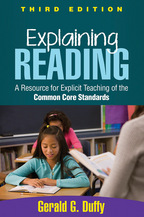Explaining Reading
Third Edition
A Resource for Explicit Teaching of the Common Core Standards
Gerald G. Duffy
1. Five Foundational Principles
2. How Comprehension and Foundational Skills Work
3. Emphasizing Large Ideas as Well as the Nitty-Gritty
4. How to Use Part II of This Book
5. Professional Judgment and Teaching to Standards
II. The Teaching Examples
Examples for Explaining Literature
Example 1. Reading for Key Details (Key Ideas and Details—RL Standard 1)
Example 2. Drawing Inferences (Key Ideas and Details—RL Standard 1)
Example 3. Theme (Key Ideas and Details—RL Standard 2)
Example 4. Character Traits and Motivations (Key Ideas and Details—RL Standard 3)
Example 5. Descriptive Words and Phrases (Craft and Structure—RL Standard 4)
Example 6. Text Types (Craft and Structure—RL Standard 5)
Example 7. Story Structure (Craft and Structure—RL Standard 5)
Example 8. Point of View (Craft and Structure—RL Standard 6)
Example 9. Illustrations and Text Meaning (Integration of Knowledge and Ideas—RL Standard 7)
Example 10. Compare—Contrast (Integration of Knowledge and Ideas—RL Standard 9)
Examples for Explaining Informational Text
Example 11. Main Idea (Key Ideas and Details—RI Standard 2)
Example 12. Making Connections and Establishing Relationships (Key Ideas and Details—RI Standard 3)
Example 13. Word Meaning (Craft and Structure—RI Standard 4)
Example 14. Using Context Clues to Determine Word Meaning (Craft and Structure—RI Standard 4)
Example 15. Text Features (Craft and Structure—RI Standard 5)
Example 16. Text Structure (Craft and Structure—RI Standard 5)
Example 17. Analyzing Positions and Views (Craft and Structure—RI Standard 6)
Example 18. Using Graphic Information (Integrating Knowledge and Ideas—RI Standard 7)
Example 19. Evaluating Supportive Evidence (Integrating Knowledge and Ideas—RI Standard 8)
Example 20. Synthesizing (Integrating Knowledge and Ideas—RI Standard 9)
Examples for Explaining Foundational Skills
Example 21. Front—Back/Left—Right/Top—Bottom (Print Concepts—RF Standard 1)
Example 22. Print Detail (Print Concepts—RF Standard 1)
Example 23. Discriminating among Sounds (Phonological Awareness—RF Standard 2)
Example 24. Letter—Sound Association (Phonics and Word Recognition—RF Standard 3)
Example 25. Vowel Patterns (Phonics and Word Recognition—RF Standard 3)
Example 26. Syllabication (Phonics and Word Recognition—RF Standard 3)
Example 27. Sight-Word Recognition (Phonics and Word Recognition—RF Standard 3)
Example 28. Structural Analysis (Phonics and Word Recognition—RF Standard 3)
Example 29. Reading with Expression (Fluency—RF Standard 4)
Example 30. Quick Recognition of Easily Confused Words (Fluency—RF Standard 4)
Appendix. Research Foundations for This Book



